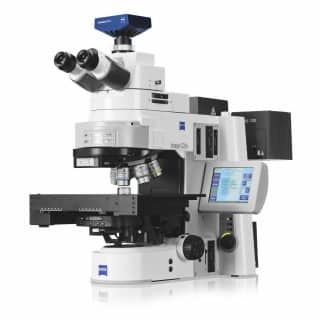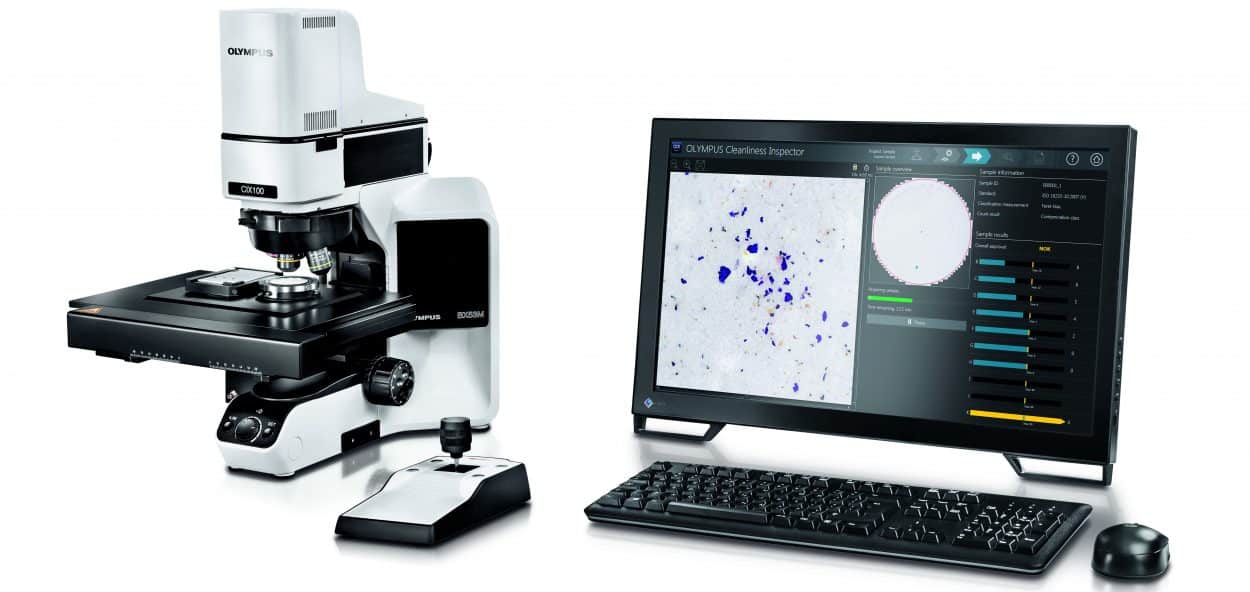Cleanliness inspection is part of the quality requirements for many manufactured parts as its goal is to measure, quantify, and validate the level of particulate contamination. Optical technology manufacturer Olympus has developed a cleanliness inspection system that can be used as a digital microscope. The OLYMPUS CIX100 cleanliness inspector is a turnkey solution composed of dedicated software connected to a high-performance optical microscope and optimized controller. We spoke with Christina Hesserling, Product Manager at Olympus Scientific Solutions to know more about their system.
How does the OLYMPUS CIX100 cleanliness inspector enable users to analyze particles?
Christina Hesserling: “Contaminants—i.e., particulates—in the millimeter or even micrometer range are inevitable in our environment. They are created in multiple ways like combustion, abrasion, wear, and in multiple industrial production processes.
Contaminants as small as a micrometer can be critical in industries like automotive, aerospace, medical device manufacturing, and others, so monitoring them has become essential. The most sensitive component of a system defines what types of contaminants, what sizes, and how many are acceptable for all components that are assembled as part of the complete system. This defines the acceptance criteria for the technical cleanliness inspection. The various requirements of different industries yield multiple standards for different applications as well as customer-specific demands.
For an analysis, the standard procedure is to wash particles from the components of interest. The washing liquid is filtered, and the residuals are captured on the filter membrane. This membrane is then inspected with the OLYMPUS CIX100 cleanliness inspector.”
What kind of particles can be analyzed and what are their sizes ?
Christina Hesserling: “The easy-to-use OLYMPUS CIX100 system enables fast analysis of particle numbers, types, and sizes. Particles between 2.5 µm and 42 mm are automatically detected and classified in size class bins according to international standards or customer-specific settings.
Live feedback enables a user to react quickly if a component fails a test. The identification of reflective particles is requested by multiple international standards due to the potentially higher risk they pose to many systems because of their hardness and conductivity.
Compared to the classical method, which requires two scans of the filter membrane to discriminate between reflective and non-reflective particles, the OLYMPUS CIX100 system’s unique optical assembly enables the user to identify reflective particles and to automatically classify them as metallic in a single scan. Once the specimen is mounted to the CIX100, the system is completely hands-free, helping reduce the risk of accidental contamination during the analysis. “
What are the key features of your solution and how do they ensure reliable analysis?
Christina Hesserling: “The key design aspects of the OLYMPUS CIX100 system are reliability, stability, ease-of-use, and high throughput. The system is equipped with an automated calibration self-check, and the administrator can control user rights. The innovative optical design has no moving parts in the optical light path. These features reduce the risk of a malfunction and help operators stay on task and produce reliable cleanliness inspection results independent of their level of experience.
The system guides the user step-by-step through the cleanliness inspection analysis so that a standard workflow is easily repeated, ending in a report based on a template selected by the operator.
The workflow can be customized with user-specific standards, inspection configurations, or report templates. Easy-to-use tools and data arrangement, including display of the cleanliness code facilitate a deeper analysis of each contaminant on the specimen.
In the data review step, thumbnails of each detected contaminant are directly linked to the 3D position of the particulate on the analyzed specimen. The thumbnails and particle list are arranged according to size and particle type, making it simple to review the largest contaminants in the specimen.
When the user selects a particulate image, the OLYMPUS CIX100 system automatically drives to this particle on the specimen, so the user can inspect it more thoroughly. Here, the user can select from multiple tools optimized for technical cleanliness inspection such as reclassifications, splitting of overlapping particles, height measurements, or recording all-in-focus images or images at higher resolution. “
How precise is your solution and how long does it take to have reliable results?
Christina Hesserling: “The OLYMPUS CIX100 cleanliness inspection system can analyze particle sizes down to 2.5 µm based on a pixel resolution of 0.63 µm. At this resolution, a complete analysis of a specimen like a filter membrane can be conducted in 10 minutes. The analysis of contaminants down to 10 µm can be performed in fewer than 3 minutes.
This inspection speed is the result of an innovative illumination and recording technique that separates reflective and non-reflective particles in a single scan, combined with the system’s full automation and intuitive software interface that guides the user seamlessly through the workflow.
The unique system design offers proven reliability and repeatability from operator to operator as well as from manufacturing site to manufacturing site.

How to Choose the Right Microscope?
Read our buying guide and make the smart choice
Which industrial sector could benefit from this technology?
Christina Hesserling: “Multiple industries require technical cleanliness inspection as an essential part of their quality control, including aerospace, medical device, oil and lubricant manufacturing, and mobility.
The growing electric mobility sector requires a transfer of technical cleanliness requirements that are well known in the automotive industry from the traditional combustion engine to electric drives. Here, the analysis of smaller particle size classes is very important.
In addition, the fast-expanding area of aerospace reusable vessels also benefits from technical cleanliness inspection since particulate contamination is a common source of failure for solar panel deployment or solid-propellant engines.
In the CIX100 system, the user can select from multiple preloaded industry standards during the analysis or define their own company standards. Reevaluation of results according to different standards can be performed in just a few clicks. Reports are automatically generated with all data required by the standards.
Thanks to the system’s stability and pre-calibration before shipment, multinational companies appreciate the high reliability, stability and repeatability of results generated with the OLYMPUS CIX100 system because they enable easy comparison of analyses captured at multiple production sites around the globe.










